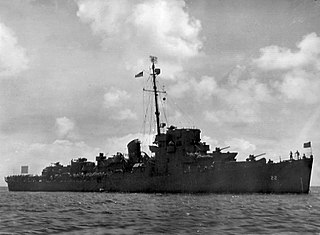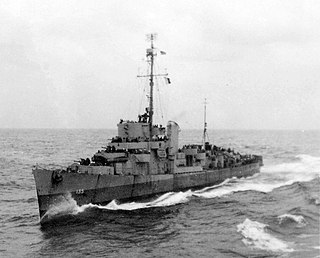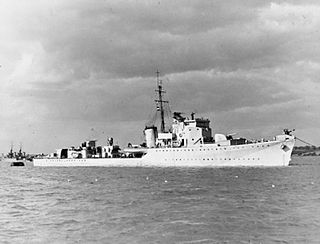
Mahan-class destroyers of the United States Navy were a series of 18 destroyers of which the first 16 were laid down in 1934. The last two of the 18, Dunlap and Fanning, are sometimes considered a separate ship class. All 18 were commissioned in 1936 and 1937. Mahan was the lead ship, named for Rear Admiral Alfred Thayer Mahan, an influential historian and theorist on sea power.

The second USS Buck (DD-420), a World War II-era Sims-class destroyer in the service of the United States Navy, was named after Quartermaster James Buck, a Civil War Medal of Honor recipient. It was built by Philadelphia Naval Shipyard and launched in 1939. It was a member of the convoy carrying the US 1st Provisional Marine Brigade. She served during the Second World War. It was sunk by the German submarine U-616 on 9 October 1943 off the coast of Salerno, when it was working in support of Operation Avalanche. It received 3 battle stars for its services during the Second World War.

USS Barker (DD-213) was a Clemson-class destroyer in the United States Navy in World War II, named for Admiral Albert S. Barker.

USS Pringle (DD-477), a Fletcher-class destroyer, was a ship of the United States Navy named for Vice Admiral Joel R. P. Pringle (1873–1932).

USS Emmons (DD-457/DMS-22) was a Gleaves-class destroyer of the United States Navy, named for Rear Admiral George F. Emmons (1811–1884).

USS Patterson (DD-392), a Bagley-class destroyer, was the second ship of the United States Navy to be named for Daniel Todd Patterson, an officer of the US Navy who served in the Quasi-War with France, First Barbary War, and the War of 1812.

USS Frankford (DD-497), a Gleaves-class destroyer, was the only ship of the United States Navy to be named for John Frankford, who commanded the privateer Belvedere during the Quasi-War with France from 1798 to 1800.

USS Chase (DE-158/APD-54) was a Buckley-class destroyer escort in service with the United States Navy from 1943 to 1946. She was scrapped in 1946.

USS Otter (DE-210), a Buckley-class destroyer escort of the United States Navy, in service from 1944 to 1947. She was finally sunk as a target in 1970.

USS Hayter (DE-212/APD-80) was a Buckley-class destroyer escort in service with the United States Navy from 1943 to 1946. In 1967, she was transferred to South Korea where she served as ROKS Jonnam until 1986.

USS Oberrender (DE-344) was a John C. Butler–class destroyer escort built for the United States Navy during World War II. She was named for Lieutenant Commander Thomas Olin Oberrender Jr., the engineering officer of the light cruiser USS Juneau, who was killed when that ship was torpedoed and sunk during the Naval Battle of Guadalcanal in 1942.

USS Halloran (DE-305) was a Evarts-class destroyer escort of the United States Navy.

USS Wileman (DE-22) was an Evarts-class destroyer escort constructed for the United States Navy during World War II. It was promptly sent off into the Pacific Ocean to protect convoys and other ships from Japanese submarines and fighter aircraft. At the end of the war, she returned to the United States proudly displaying four battle stars.

USS Manlove (DE-36) was an Evarts-class destroyer escort of the United States Navy during World War II. She was promptly sent off into the Pacific Ocean to protect convoys and other ships from Japanese submarines and fighter aircraft. She performed dangerous work in numerous battle areas, and was awarded five battle stars.

USS Flaherty (DE-135) was an Edsall-class destroyer escort in service with the United States Navy from 1943 to 1946. She was sold for scrap in 1966.

USS Herbert C. Jones (DE-137) was an Edsall-class destroyer escort built for the U.S. Navy during World War II. She served in the Atlantic Ocean and provided destroyer escort protection against submarine and air attack for Navy vessels and convoys.

USS Keith (DE-241) was an Edsall-class destroyer escort in service with the United States Navy from 1943 to 1946. She was scrapped in 1974.

HMS Laforey was an L-class destroyer of the Royal Navy. She was commissioned in and served during the Second World War, and was torpedoed and sunk by a U-boat in 1944. She had been adopted by the civil community of Northampton in November 1941.

The second HMS Hambledon was a Hunt-class destroyer of the Royal Navy in commission from 1940 to 1945. She was a member of the first subgroup of the class, and saw service throughout World War II.
HMS Blencathra (L24) was a Hunt-class destroyer of the Royal Navy in commission from 1940 to 1948. She was a member of the first subgroup of the class, and saw service through most of World War II.




















